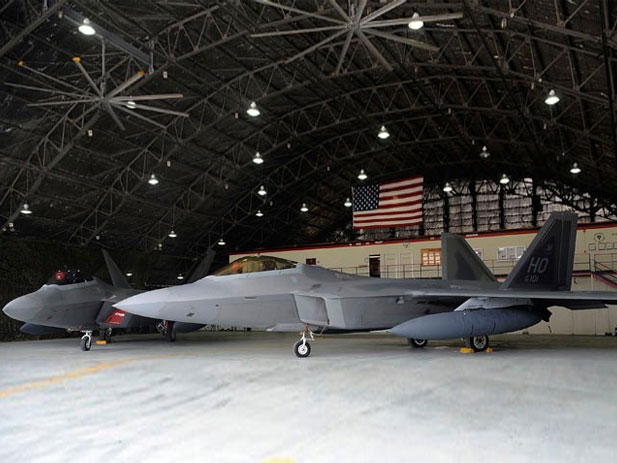
F-22 Fighter Ready for War Despite Mystery Problem: U.S. Air Force

America's most expensive fighter plane is ready for combat despite some of its pilots experiencing repeated and mysterious apparent breathing problems that have put a quick end to multiple training missions, Air Force officials said today at a special briefing.
In nearly two dozen cases in the past four years, pilots have reported experiencing "hypoxia-like" symptoms in the $143 million-a-pop stealth F-22 Raptor. Though the incidents are extremely rare, the Air Force is so concerned that they've taken a "911 call approach" – meaning that if a pilot gets the slightest indication that anything is wrong, he's directed to end the training mission and turn back to base. The fleet of next generation fighters, which cost $77.4 billion total, have been considered combat operational since 2005, but none have been used in a single combat mission from Iraq and Afghanistan to Libya.
That doesn't mean the F-22 couldn't go to war at a moment's notice, Air Force Maj. Gen. Noel Jones said today.
"If our nation needs a capability to enter contested air space, to deal with air forces that are trying to deny our forces the ability to maneuver without prejudice on the ground, it will be the F-22 that takes on that mission," Jones, Director of Operational Capability Requirements, said at a special briefing at the Pentagon held to address concerns with the beleaguered F-22. "It can do that right now and is able to do that without hesitation."
Air Force officials also unveiled the findings of a Scientific Advisory Board Study, which was convened to investigate the plane's life support systems. The study, led by Gen. Gregory Martin (Ret.), failed to discover the source of the oxygen problems but listed several related shortcomings with the plane and announced 14 different recommendations.
At the same briefing, the top Air Force official in charge of F-22 operations, Maj. Gen. Charles Lyon, said he stood behind a controversial Air Force investigation report that blamed an F-22 pilot for the crash that took his life, despite the malfunction that completely shut off his oxygen. Capt. Jeff Haney died when his plane crashed into the Alaskan wilderness in November 2010.
The Pentagon Inspector General's office is reviewing the Air Force's investigation, the first such major review in nearly two decades.
Recently the Air Force announced it was replacing the emergency oxygen system handles in all of its F-22s. In Haney's case the emergency oxygen system was never deployed, and the Air Force report had noted that pilots may have difficulty reaching the handle in their cumbersome winter gear.
Air Force: Pilots 'Absolutely Not' at Unnecessary Risk
After a quick succession of safety scares in the last days of April and the beginning of May in 2011, the Air Force grounded the full fleet of F-22s while it investigated the "physiological events" the pilots had reported. But after nearly five months of intense testing and evaluation that produced no smoking gun, the Air Force cautiously allowed the planes back in the air.
The problem, however, has persisted. In at least nine other incidents since the grounding, pilots have reported the "hypoxia-like" symptoms, according to the Air Force. Hypoxia is caused when the brain is deprived of oxygen, causing disorientation, dizziness, poor judgment, and, eventually, unconsciousness.
PHOTO: An Air Force F-22 Raptor sits in front of the new Fuel Composite Overhaul Test Facility at Hill Air Force Base, Utah.
U.S. Army
An Air Force F-22 Raptor sits in front of the... View Full Size
Jones said that flying all fighter planes is dangerous, but maintained that even though the problem has not been solved, pilots are "absolutely not" being put at additional, unnecessary risk by flying training and homeland security missions in the planes.
"Pilots are at risk every time that we strap an airplane on… [W]hat we do is critical to our nation," Jones said. "And we are in full belief that the steps that are in place by Air Combat Command, the recommendations that General Martin's board came up with, have given us a very safe airplane while we work to ultimately determine what the root cause is. This airplane is safe and capable of flying."
Source: By LEE FERRAN / March 29, 2012 (abcnews.go.com)
Photo: U.S. Air Force F-22 Raptor fighter jets are seen at the U.S. air base July 26, 2010 in Osan, South Korea. (Kim Min-Hee/Getty Images)
(29.03.2012)
|